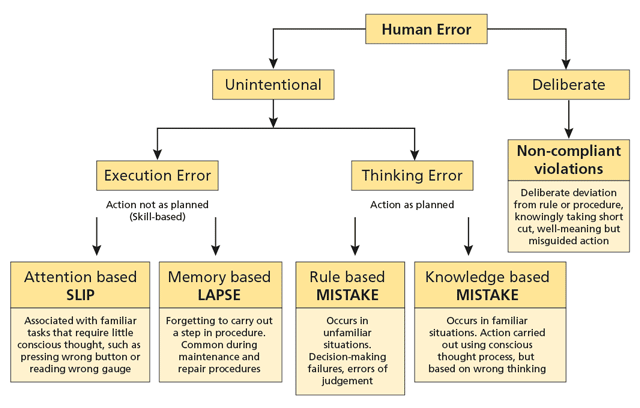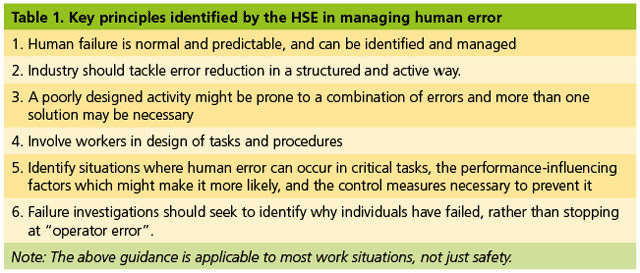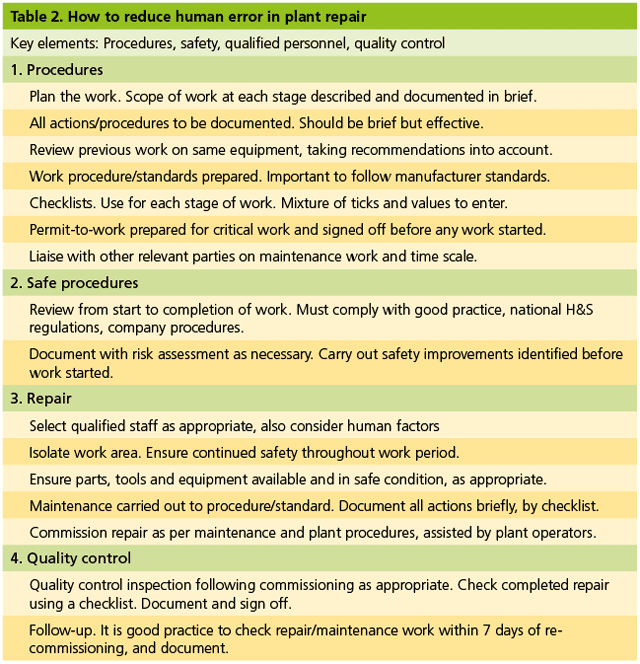 ABSTRACT
ABSTRACT
Human errors are made by everyone to varying degrees, and come into every aspect of plant operations, from design, construction, operation, maintenance and management to safety.
Considerable research has taken place since early times to understand human behaviour more fully in order to reduce the impact of human error in society [1 – 7]. For example, the journal Human Factors reports on many topics relating to human performance, especially ergonomics, which is the study of human efficiency in the working environment [1]. The Health and Safety Executive (HSE) [2] investigates accidents in industry, and makes recommendations on changing work practices to reduce accidents, while recognising the accompanying role of human error.
The extent of human error is not always fully recognised. For example, the bursting of a process pipeline may be blamed on a faulty pressure relief valve, but further investigation may find that other factors related to human error were the main contributor, such as incorrect valve type, incorrect pressure relief setting, damage in the past, over-pressurisation or poor maintenance. Likewise, most plant accidents are caused by human error.
The purpose of this paper is to highlight the role of human error in plant operations, and provide practical guidance on reducing its impact in the actual plant maintenance itself. The comments made are applicable to the broader maintenance function and to most plant operations and situations, including safety, because human error causes have a common origin, as do approaches to solutions.
Understanding human error
A description of human error and behaviour can be found in many publications, and the reader is referred to these for an overview of the subject [3 – 7]. Psychologists have classified human error broadly into several different types in order to understand the associated human behaviour more fully. Rasmussen [7] developed a widely accepted skill-rule-knowledge model of human error (Figure 1).

Execution errors are skill-based, while planning errors are rule and knowledge based. Slips are considered as errors in carrying out an intended action to reach an objective, whereas mistakes are errors in choosing an objective or specifying a method of achieving it. Carrying out a deliberate act which violates a known standard or expected practice may also be regarded as human error.
It is generally acknowledged that at least 80-90% of accidents are due to human error, and a similarly high figure relates to failures in plant operations. Statistics on human error occurrence vary according to the work situation, but one estimate of the relative occurrence of human error types in general finds that 61% are skill-based, 27% rule-based, and 11% knowledge-based [7]. Built into these frequencies are corrections identified by individuals based on the recognition of their own limitations; the same report estimated that 70% of errors are detected and corrected in skill-based errors, 50% in rule-based errors, and 25% in knowledge-based errors.
It is easy enough to recognise the various types of human error in practice; taking action to mitigate them is the difficulty. The basic approach to error management is to look at changing the individual or work environment. Humans cannot change their fundamental human nature, but they can recognise and learn from common errors, and hence reduce their frequency of occurrence. All humans are different, and hence the degree to which they can self-correct varies considerably; the challenge is to recognise individual limitations or abilities in the workplace.
Judging a person for a particular role or job depends on an assessment first of their qualifications and experience, and second on their work ethic. Most decisions in the workplace take human behaviour into account, often not in a conscious analytical way, but based on a general knowledge of the suitability of the person involved. Testing or assessing a person for suitability is carried out in some organisations and depends on the role itself. For example, bus drivers are widely assessed for suitability, as are control operators in complex or critical process plant.
Since humans vary so much in behaviour and hence human error susceptibility, it is easier and more productive to focus on reducing human error in the long term by making changes in the workplace that affect people equally. Changing workplace situations and practices is a widely adopted approach in addressing accidents due to human error, and applies to all workplace situations including plant operations and maintenance. The Health and Safety Executive in the UK monitors and makes recommendations on measures to reduce workplace accidents due to human error (Table 1).
 Many practical factors need to be taken into account in reducing human error in the workplace, depending on the situation, such as:
Many practical factors need to be taken into account in reducing human error in the workplace, depending on the situation, such as:
1. Be aware of common human errors when designing plant and preparing instructions and procedures
2. Put action instructions in writing (eg e-mails are quick but require evidence that they have been read and understood. Changes to procedures must be written into the procedure itself, and acknowledged by personnel)
3. Make procedures brief but clear and instructive (consider putting as much detail as possible in an appendix)
4. Standardise procedures (eg of set actions in the way different plant is operated)
5. Prepare checklists for the more error-prone tasks (checklists to be completed, with some answers requiring data entry to avoid a repetitive tick)
6. Reduce the number of steps in task procedures (the probability of errors occurring increases with the number of steps, and the complexity of the task)
7. Avoid using excessive control instrumentation (instruments fail and may not be serviced properly, itself introducing further human error)
8. Avoid overloading computer screens with information, but don’t hide key information
9. Never forget quality control after the work is completed. Incomplete workmanship is a major cause of equipment failures.
10. Provide a congenial and safe working environment (reduces human stress)
11. Discuss and work with employees to achieve instructive and acceptable change (re-deployment of error prone staff needs careful and honest management)
12. Understand basic human behaviour: it will help improve communication with employees, produce a more congenial workplace and hence reduce human error.
An understanding of human perception is very useful in managing human error. For example, clear presentation both visually and perceptively of documents and actions required for any workplace task helps the mind to grasp the issues with greater clarity, in turn reducing the probability of human error. In the author’s experience as a plant engineer, documenting procedures is fundamental in helping improve clarity of the task. Documents should be brief and clear but instructive, and cover all actions.
Reducing human error in plant maintenance
Analysing human error and applying measures to reduce its occurrence in all work situations are widely reported, including in plant maintenance [8-12].
Human errors in maintenance are found to be a major cause of plant failure and accidents. This result can also be expected from a consideration of the work situation itself. New equipment is made and assembled under standardised manufacturing conditions which usually involve a high level of quality control. Plant design and installation is usually subject to a lesser but nevertheless planned level of quality control.
Repair and regular maintenance of plant in a working environment, on the other hand, involve personnel with a wide range of expertise and abilities, which cannot be controlled to the same level as in a manufacturing plant. This emphasises the need to check all maintenance work on completion, however minor. Checking a repair or maintenance issue is often not carried out thoroughly enough, and to a high level of accepted quality control only in exceptional situations, such as nuclear facilities or aircraft maintenance. Even simple maintenance work could benefit from some degree of simple quality control or checking. This is where checklists can prove useful.
Many published reviews have highlighted the role of maintenance in plant failure, and provided advice on how to reduce human error. For example, it was found that 20% of all system failures in fossil power plants occur due to human failures, 56% of forced outages occur less than a week after a planned or maintenance shutdown, and 55%-65% of all problems were associated with maintenance are related to human performance [10]. The following principles were recommended to reduce human error:
- Train people in human factors
- Remember that every extra pair of eyes is a chance to identify a problem before it happens
- This applies even more so for fresh pairs of eyes
- Build a culture that is intolerant of error
- Treat every recovery as an opportunity to learn
- Employ experts
- Examine tasks and processes
- Learn from other industries.
There is a common trend in the types of human error that occur in plant maintenance in many industrial activities. Incomplete installation or faulty procedures appear to be the most common types of error. In power plants, for example, the following human causal factors for critical incidents and reported events relating to maintenance were found, in order of most to least frequent [11]:
- Faulty procedures
- Problems in clearing and tagging equipment for maintenance
- Shortcomings in equipment design
- Problems in moving people or equipment
- Poor training
- Poor unit and equipment identification
- Problems in facility design
- Poor work practices
- Adverse environmental factors
- Mistakes by maintenance personnel.
Maintenance is a widely performed activity, and an examination of maintenance procedures shows that most in established activities are well documented, having been based on experience over time, such as in motor car and aircraft maintenance to mention two. If this is the case, why are plant failures due to human error still common? Clearly, the human element is a major factor. The key to reducing human error is to continually concentrate efforts on making procedures more user-friendly to carry out, to modify or improve the work situation itself, and to check the work following completion, while not forgetting the human element.
In the author’s practical experience, the main elements of maintenance that offer scope for improvement in particular are documentation (procedures) and inspection (after completion of work) (Table 2). The collection of documentation prior to commencement of the work is often inadequate, especially of previous maintenance work on the same task, as is reporting of the work after completion. Work is seldom completed fully, in particular the final testing and validation. The reason for the latter is partly psychological: the operator has devoted much time, thought and effort to the job and at the completion is keen to finish it and move on with other work. For the same reason, recording the work thoroughly itself loses importance after its completion. These actions are seldom addressed in small jobs where consequences of error are perceived as minimal, but are absolutely essential for large, complex and critical maintenance.
 The instructive presentation and formatting of procedures is very important since it helps staff understand and assimilate the work situation more easily, in turn reducing the chance of errors. Procedures should be brief but instructive; more detail not relating directly to carrying out the work can be covered in an appendix. Presenting procedures as much as possible in table or flow diagram form improves their assimilation. Standardising procedures and the way similar actions are carried out can help reduce the likelihood of error.
The instructive presentation and formatting of procedures is very important since it helps staff understand and assimilate the work situation more easily, in turn reducing the chance of errors. Procedures should be brief but instructive; more detail not relating directly to carrying out the work can be covered in an appendix. Presenting procedures as much as possible in table or flow diagram form improves their assimilation. Standardising procedures and the way similar actions are carried out can help reduce the likelihood of error.
In addition to addressing human actions in maintenance itself, attention should focus on designing equipment and the workplace with error tolerance a consideration. Equipment is becoming more complex, especially with increased instrumentation and automated control, and hence there is a need to design equipment for easier and thus improved maintenance. The philosophy of designing equipment for easy and instructive maintenance is widely practised, and can help reduce human error. The approach is to take the following factors into account: accessibility, modularity, simplicity, standardisation, and making foolproof.
Inadequate management of the maintenance function and performance can introduce errors. In fact, management is responsible for the most costly errors because they have to make critical decisions at a high level, often based on an incomplete knowledge of the actual practical situation and consequences of their actions at a basic level. Poor management of the personnel structure and changes contributes to errors; consultation on changes is important as this reinforces the co-operative team effort.
There is a perception that increased automation can reduce human error, but this is not necessarily the case, since humans have to install, set and maintain the instrumentation, which again introduces the human error element. Lack of appreciation of the sensitivity spectrum of instrumentation, and its reliability, contributes to failures. Experience of working in a water utility has shown the author that many plant failures are related to instrumentation, particularly spurious signals which knock out pumps or communication links and mostly require simply resetting.
Conclusion
Human error is something everyone understands and can relate to, which makes it easier to discuss and to put co-operative measures in place to reduce its impact.
The most important points to reducing human error in maintenance are having clear documented procedures, and checking the work after completion (quality control). Procedures should be clearly formatted, but as brief and instructive as the work allows. The use of standardised (peer reviewed) procedures will help reduce human error.
The automation of plant is increasing with less human effort in actual plant operation than in the past. This does not necessarily reduce human error, since automation itself always involves more control steps and has to be managed and maintained by humans. Automation is increasingly complex and raises the question of the ability of qualified staff to manage it instructively.
A useful guide to bear in mind where humans are involved is that the more steps that need to be taken to achieve an objective in human effort terms as well as in the automation process itself, the more likely there are to be errors.
References
1. Human Factors, Journal published by Human Factors and Ergonomics Society, USA.
2. Reducing Error and Influencing Behaviour, Health and Safety Executive (HSE), UK, HSG48, 1999.
3. Reason, J. Human Error, Cambridge University Press, 1990.
4. Warr, P. (Ed). Psychology at Work, Penguin Books, 1996
5. Dekker, S. The Field Guide to Understanding Human Error, Ashgate Publishing Ltd, 2014.
6. Human error types, SKYbrary, Wiki. www.skybrary.aero/index.php
7. Rasmussen, J. Human errors: a taxonomy for describing human malfunction in industrial situations, J. Occupational Accidents, pp. 311 – 333, Vol. 4, 1982.
8. Reason, J. and Hobbs, A. Managing Maintenance Error, Ashgate Publishing Ltd, 2003.
9. Improving maintenance: A guide to reducing human error, Health and Safety Executive (HSE), UK, 2000.
10. Seminara, J.L., and Parsons, S.O. Human Factors Engineering and Power Plant
Maintenance, Maintenance Management International, Vol. 6, 1985, pp. 33–71.
11. Atkinson, T. Individual, team and organisational human factors, ABB Group, 2014.
12. Dhillon, B.S. Safety and Human Error in Engineering Systems, CRC Press, USA, 2014
 Dr Ron Davies is a control engineer with Thames Water Utilities in the UK. He can be contacted at ron.davies@thameswater.co.uk
Dr Ron Davies is a control engineer with Thames Water Utilities in the UK. He can be contacted at ron.davies@thameswater.co.uk

